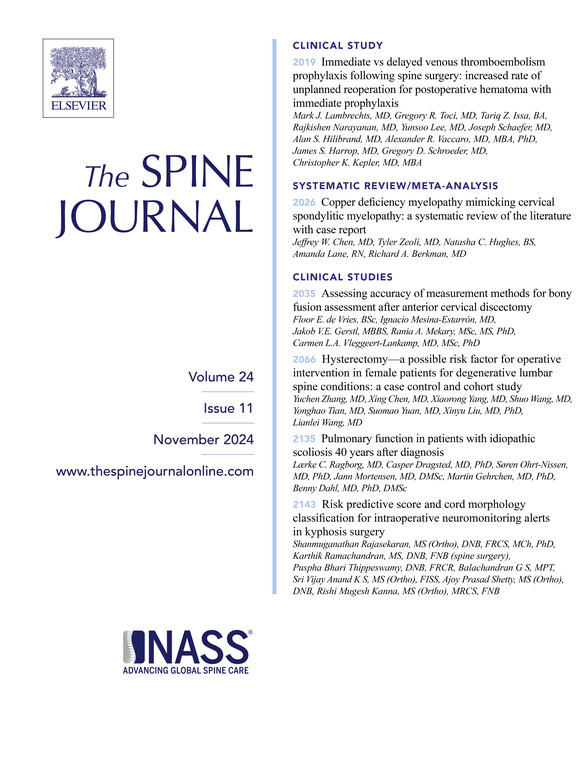颅骨方向对放射检查时颈椎矢状排列的影响:放射学分析。
IF 4.9
1区 医学
Q1 CLINICAL NEUROLOGY
引用次数: 0
摘要
背景情况:在放射成像检查过程中,颅骨方向不仅会因人而异,而且同一受检者在不同的成像过程中颅骨方向也会不同。目的:以无症状人群为研究对象,用放射学方法研究颅骨方向对颈椎矢状对位的影响:研究设计:前瞻性放射学研究:患者样本:80 名无症状志愿者(平均年龄 40.4 岁;50.0% 为男性):结果测量:颈椎矢状面参数,包括区域斜度(C1斜度、C2斜度、C5斜度、C7斜度和T1斜度)、Cobb角(O-C1角、C1-C2角、C2-C5角、C5-C7角和C7-T1角)和颅颈偏移(蝶鞍倾斜[ST倾斜]和C2倾斜):所有参与者均在三种前视体位下拍摄颈椎站立侧位片,即前倒颅位(AC)、中立颅位(NC)和后倒颅位(RC)。对这三种体位下的颈椎矢状面参数,包括区域斜率、Cobb角和头颅/颈椎偏移量进行了统计比较:结果:与 NC 体位相比,AC 和 RC 体位的 C1 和 C2 斜度分别前倾和后倾。三个位置的 C5 斜坡、C7 斜坡和 T1 斜坡保持不变。在O-C2和C2-C5中,三种体位的区域Cobb角在统计学上有显著差异;但在C5-C7或C7-T1节段中没有显著差异。当头颅前倾和后倾时,ST倾斜和C2倾斜的头颅和颈椎偏移分别增加和减少:本研究表明,在无症状人群中,拍摄颈椎X光片时颅骨方向的调整主要受控于O-C2节段的上颈椎。在拍片时,O-C2 上段颈椎的排列会发生变化;相应地,C2-C5 中段颈椎的排列也会在调整头颅方向时发生变化。但是,C5-C7 的颈椎下段和 C7-T1 的颈胸交界处的对线保持不变。此外,头颅前倾和后倾时,头颅/颈椎偏移分别增加和减少。我们的研究结果有助于在临床实践中准确评估平片上的颈椎矢状排列。本文章由计算机程序翻译,如有差异,请以英文原文为准。
Influence of cranium orientation on cervical sagittal alignment during radiographic examination: a radiographic analysis
BACKGROUND CONTEXT
During the radiographic examination, the cranium orientation varies not only individually but also within the same subject, in different imaging sessions. Knowing how changes in the orientation of the cranium influences cervical sagittal alignment during the radiographic examination of the cervical spine can aid clinicians in the accurate evaluation for cervical sagittal alignment in clinical practice.
PURPOSE
To radiographically examine the influence of cranium orientation on cervical sagittal alignment during radiographic examination in an asymptomatic cohort.
STUDY DESIGN
A prospective radiographic study.
PATIENT SAMPLE
Eighty asymptomatic volunteers (mean age, 40.4 years; 50.0% male) were enrolled.
OUTCOME MEASURES
Cervical sagittal parameters including the regional slope (C1 slope, C2 slope, C5 slope, C7 slope, and T1 slope), Cobb angle (O–C1 angle, C1–C2 angle, C2–C5 angle, C5–C7 angle, and C7–T1 angle), and cranial/cervical offset (sella turcica tilt [ST tilt] and C2 tilt).
METHODS
In all participants, standing lateral radiographs of the cervical spine were taken in 3 forward-gazing positions: anteverted-cranium (AC) position; neutral-cranium (NC) position; and retroverted-cranium (RC) position. Cervical sagittal parameters, including the regional slope, Cobb angle, and cranial/cervical offset, in these 3 positions were statistically compared.
RESULTS
The C1 and C2 slopes were anteverted and retroverted in the AC and RC positions, respectively, compared to those in the NC position. The C5 slope, C7 slope, and T1 slope were constant among the 3 positions. In O–C2 and C2–C5, statistically significant differences in the regional Cobb angles were identified among the 3 positions; however, there were no significant differences in the C5–C7 or C7–T1 segments. Cranial and cervical offsets of ST tilt and C2 tilt increased and decreased when the cranium was anteverted and retroverted, respectively.
CONCLUSIONS
The current study suggests that the adjustment of the cranium orientation when taking cervical spine radiographs is mainly controlled at the upper cervical spine of the O–C2 segment in an asymptomatic cohort. On radiograph, alignment in the upper cervical segment of O–C2 changes; accordingly, the middle cervical segment of C2–C5 can change during the adjustment of cranium orientation. However, alignment in the lower cervical segment of C5–C7 and the cervicothoracic junction of C7–T1 remains constant. Further, cranial/cervical offset increases and decreases when the cranium is anteverted and retroverted, respectively. Our results can help the accurate evaluation of cervical sagittal alignment on plain radiographs in clinical practice.
求助全文
通过发布文献求助,成功后即可免费获取论文全文。
去求助
来源期刊

Spine Journal
医学-临床神经学
CiteScore
8.20
自引率
6.70%
发文量
680
审稿时长
13.1 weeks
期刊介绍:
The Spine Journal, the official journal of the North American Spine Society, is an international and multidisciplinary journal that publishes original, peer-reviewed articles on research and treatment related to the spine and spine care, including basic science and clinical investigations. It is a condition of publication that manuscripts submitted to The Spine Journal have not been published, and will not be simultaneously submitted or published elsewhere. The Spine Journal also publishes major reviews of specific topics by acknowledged authorities, technical notes, teaching editorials, and other special features, Letters to the Editor-in-Chief are encouraged.
 求助内容:
求助内容: 应助结果提醒方式:
应助结果提醒方式:


